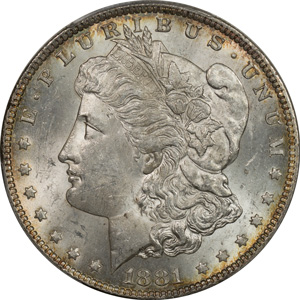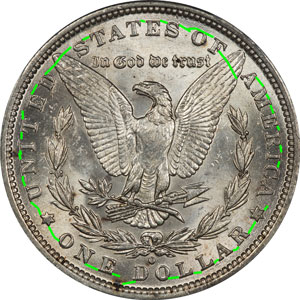
March-April 2020 - Welcome
Sources
Search
Contact
Home
Welcome
Click on year to expand
2022
2021
2020
2019
2018
2017
2016
2015
Welcome
Die Crack Grouping
As we ended the year and look back a lot happened and we can only hope that there will be an equal level of activity in 2019.
![]()
![]() VSS Submissions
VSS Submissions
We have four coins to send to Leroy for analysis and that needs to get going in January. Hopefully there is a little something new in the group.
![]()
Die Fingerprints
In February we started an analysis of the five VAM's associated with Reverse Die n. This month we are turning our attention to resolving conflicts found using the die crack analysis.
The five VAM's in the discussion are:
30 - Doubled 1-1, Earlobe, Reverse Legend & Motto
37 - Doubled Reverse Legend & Motto
37A - Doubled Reverse Legend & Motto, Clashed Obverse n, us
37B - Doubled Reverse Legend & Motto, Beveled Field STAT & AM
59 - Doubled Reverse Legend and Motto
To recap those findings here are some notes.
1. All VAM 30, 37A, and 59 coins show a consistent obverse and reverse pattern.
2. Coins currently classified as VAM 37 had some consistency with half showing a pairing of Obverse Die DCO2 and Reverse Die DCR0.
3. Coins currently classified as VAM 37B showed a dominant pattern of DCO3 and DCR1.
4. VAM's 37 and 37B need more work to better document the differences and to more throughly examine the coins that fell outside the most frequent pairing.
![]()
The coins are grouped below as we now have them classified either VAM 30, 37, 37A, 37B, or 59.
PCGS
VAM
30
30
30
30
30
30
30
30
30
30
30
30
30
30
30
30
30
30
30
37
37
37
37
37
37
37
37
37
37
37A
37A
37A
37A
37A
37A
37B
37B
37B
37B
37B
37B
37B
37B
37B
59
Final VAM
30
30
30
30
30
30
30
30
30
30
30
30
30
30
30
30
30
30
30
37
37
37
37
37
37
37
37
37
37
37A
37A
37A
37A
37A
37A
37B
37B
37B
37B
TBD?
37B
37
37B
37B
59
Obverse
DCO1
DCO1
DCO1
DCO1
DCO1
DCO1
DCO1
DCO1
DCO1
DCO1
DCO1
DCO1
DCO1
DCO1
DCO1
DCO1
DCO1
DCO1
DCO1
DCO2
DCO0
DCO2
DCO0
DCO0
DCO2
DCO2
DCO0
DCO1
DCO2
DCO3
DCO3
DCO3
DCO3
DCO3
DCO3
DCO3
DCO3
DCO3
DCO3
DCO0
DCO0
DCO2
DCO3
DCO3
DCO0
Reverse
DCR0
DCR0
DCR0
DCR0
DCR0
DCR0
DCR0
DCR0
DCR0
DCR0
DCR0
DCR0
DCR0
DCR0
DCR0
DCR0
DCR0
DCR0
DCR0
DCR0
DCR0
DCR0
DCR0
DCR0
DCR0
DCR0
DCR1
DCR1
DCR0
DCR1
DCR1
DCR1
DCR1
DCR1
DCR1
DCR1
DCR1
DCR1
DCR1
DCR1
DCR1
DCR0
DCR1
DCR1
DCR0
GRADE
58
58
58
58
61
61
61
61
61
62
62
63
63
63
63
63
63
64
64
53
53
55
60 DMPL
61
61
62
63
63
64
55
55
55
61
61
62
40
53
53
55
62
63
64
64+
65
62
Obverse Designations for This Discussion
DCO0
DCO1
DCO2
VAM's 37, 37B, and 59 all had coins exhibiting no die cracks. This was the dominant die for VAM 59, but we only have one example. With VAM's 37 and 37B we need to look for other features to see if this is die wear state or really a different die.
This is the die crack pattern that showed up on VAM 30 and it is similar to, but different than, DCO3 used with VAM's 37A and 37B. One noticeable difference is that the crack goes below the bust point on DCO1 and through the bust point on DCO3.
This is the die crack pattern that showed up on VAM 37 and it seems to be distinctive and unique to that VAM. But does this pattern show up in later VAM's 37A or 37B? Are there other PUPs that would identify the die states of VAM's 37A and 37B that link DCO2 and DCO3?

DCO3
This is the die crack pattern that showed up on VAM's 37A and 37B and possibly links them to the same physical die, just a clashed and unclashed state.
Reverse Designations for This Discussion
DCR0
DCR1
The reverse dies for this series at the highest level show either no die cracks or perimeter die cracks. Last month it appeared that VAM's 30 and 37 had no die cracks. But are these the same physical die or just early die states of two different dies?
This is obviously the version with perimeter die cracks. The die cracks appear on VAM's 30, 37, and 37A in last month's analysis. They seem to be in different states of deterioration, but on closer examination will they prove to all be one die or multiple dies?
VAM 37 - Doubled Reverse Legend & Motto
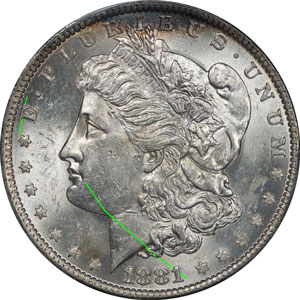
DCO2
We believe that this is the correct obverse die for VAM 37 and that this was the die intended to represent this VAM.
However, there are five other coins that need to be examined to see if they are a match, just a different die state.
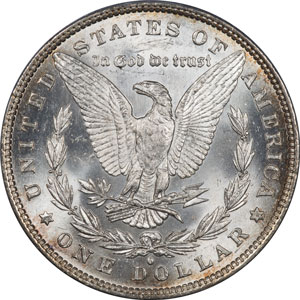
DCR0
We believe that this is the correct reverse die for VAM 37 and that it should exhibit no die cracks. We have two coins with what seems to be a different reverse and these need additional examination.
The Five That Need Work
In our earlier analysis there were five coins that did not seem to fit the pattern of DCO2 and DCR0 as most of the coins did for VAM 37.
These five are 83959922, 07265435, 81801056, 31579663, and 80451693. We will look at these five in order to see if they are something new or just misclassified.
DCO0 with DCR0 Combination
DCO0 with DCR1 Combination
DCO1 with DCR1 Combination
In theory this would be the correct reverse die paired with an obverse die lacking the die crack through the cheek. This would be a consistent pattern for coins 83959922, 07265435, and 81801056.
It is difficult to determine if these three are different physical dies. They do exhibit enough consistent features to keep them grouped and probably consider them to be a different die state of the same die as the other VAM 37 coins.
There are some very small features in the hair curls that lead us to conclude that these three preceded the die cracks found on DCO2.
So for lack of other evidence we have to add these three to the VAM 37 group.
These three lack the features to match with VAM 59 even though they lack die cracks.
We have only one coin that fits this description, 31579663. This coin has no obverse die cracks, but the die has been heavily repolished and can be identified in the hair and mouth as a repolished die because of the lack of detail.
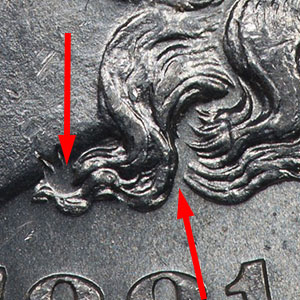
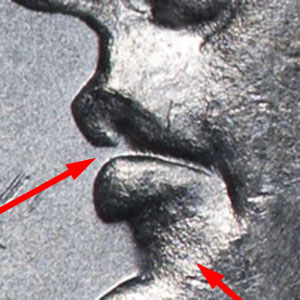
Is this definitive, NO, but there is a lack of evidence to call this anything other than a repolished version of the coins with the die crack through the cheek or other parts of the die.
This obverse, on this coin, could be a repolished version of any of the others.
What about the reverse? The reverse definitely has the some of the die cracks exhibited most often with VAM 37A. But they do not cover the complete circumference of the die. This probably indicates that this is a die state that is "on the road" to the clash and further die cracks.
This coin also lacks the clash of VAM 37A and cannot, therefore, be considered the VAM 37A reverse.
We think it is most likely that this is a die state that fell toward the end of VAM 37 and before VAM 37A. It does have the doubled Legend and Motto.
It probably should still be considered a VAM 37.
As with the DCO0/DCR1 coin, we have only one of these. Because of the toning it takes a lot of work to identify the coin's features. On closer examination this has the same repolishing as the DCO0 coin, 31579663. But the coin also shows the beginnings of the die cracks in DCO3. So this is most likely just a slightly different state on the road to more die cracks around the circumference.
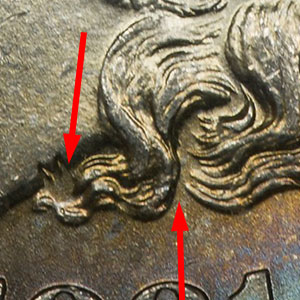
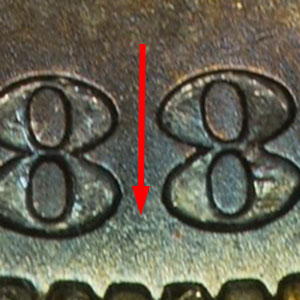
What about the reverse on this coin? This one has the die cracks around the circumference, but not completely formed. It also has a slightly beveled field.
But it lacks any evidence of a clash to throw it into the 37B grouping. So this one becomes a 37 even though it is a transitional coin between the two VAMs.
VAM 37B - Doubled Reverse Legend & Motto, Beveled Field STAT & AM
As we look at this whole group we begin to see that most of the reverses have a beveled field, it is an issue of degree and not presence of the feature.
But the anomalies in this group may prove to be a little different. There were two coins that needed further analysis, 29282205 and 30403236.
29282205
This coin will be a subject of further investigation next month as it contains some features That point to something new.
The obverse has a doubled 18-1 which does no match any other VAM 37B coins. This is a pattern that could match other recognized dies, but we want to take our time with it as this would be a new die pairing.
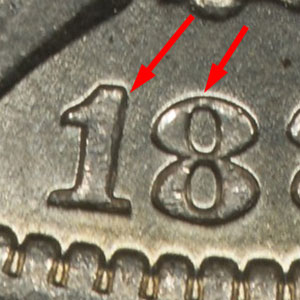

The reverse of the coin does seem to be the same die as the other VAM 37B coins.
30403236
This coin is probably identified correctly and lacks obverse die cracks because of heavy repolishing.
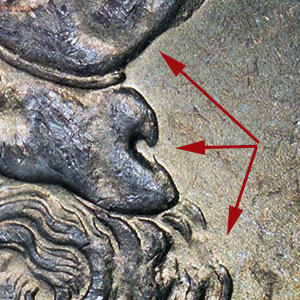
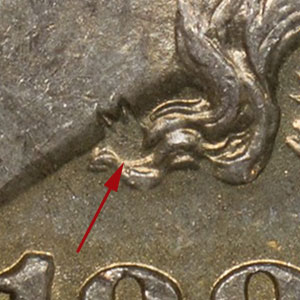
The excessive polishing can be seen at the hair lines and back of the cap.
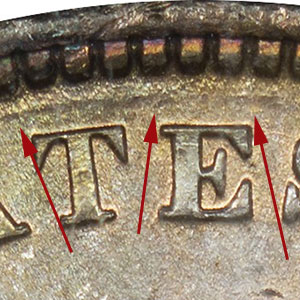
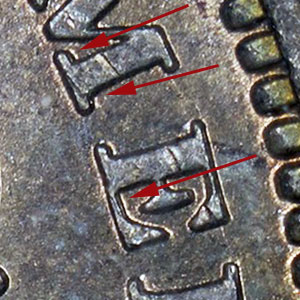
The field beveling and doubling is easily identified.
Getting Started
Collecting The 1881-O
The 1881-O VAMs





















